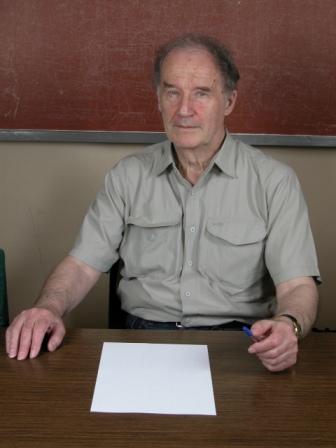 |
RSS feeds |
|
|||||
| Issue 12, 2025 |
|
||||||
|
|
|
||||||

|
60 seconds with authorsRitus Vladimir I.Lebedev Physics Institute, Russian Academy of Sciences, Moscow, Russia
What led you into science and your chosen area of research?
My interest in atomic physics. It was born when I was a first-year student at the Moscow Aviation Institute (MAI) and attended Professor Khodakov's lectures on chemistry saturated with atomic physics. I sat for an examination with him on 21 July 1945, while the first test of atomic bomb took place in New Mexico a week before that. My interest grew to such a degree that I transferred to the Physics department of the M.V. Lomonosov Moscow State University. Can you describe the results in your paper and their importance for your field?
In two papers published by your journal in 2007 and 2008 I needed to return to my paper of 1961 in which I obtained three-parameter expressions for the angle ω — the angle of rotation of a particle's spin under the Lorentz transformation of its velocity. Each of the three generalizes the two-parameter Wigner formula for ω. Now they helped me to correct the Møller formula for this angle as it yields an incorrect ultrarelativistic limit. What research projects are you working on at the moment? I am searching for additional arguments in favour of the geometrical nature of quantization of the bare charge. What do you think will be the next big breakthrough in your field? I wish quantum electrodynamics to achieve some degree of clarity with respect to the relation between electric charge and Planck's constant, and greater clarity about fractional values of charges of quarks and charge carriers in the fractional quantum Hall effect. What book are you reading right now? Reading Sergei Dovlatov's "Zona", "Zapovednik", "Remeslo", "Zapisnye knizhki", "Inostranka". Working on my comprehension of Joseph Brodsky and Aleksandr Mezhirov. If you could have dinner with any 3 people, past or present, who would they be and why? I'd love to get together — and not for dinner but for a long spell, and even for always — with my dear friend David Kirzhnits, with Andrei Dmitrievich Saharov - who meant so much to me, influenced me enormously, was so close to me in spirit. I'd love to have a talk with Freeman Dyson about the geometrical quantization of charge which results in the value α0 = 1/4π for the bare fine structure coupling. What has been the most exciting moment in your career so far? When I was working on my diploma project, I discovered that emission of two γ-quanta by a barely noticeable grain of radioactive 60Co (in fact, by a product of its beta-decay 60Ni) essentially depends on the angle between momenta of the quanta. It happened during the night, in a room that was copper-clad on the inside to suppress outside interference. I understood that Nature was trying to tell me something in confidence about Itself. Ever since then I am trying to prove that I deserved that confidence. What would you like to say in connection with the 90th anniversary of "Uspekhi Fizicheskikh Nauk" journal? I would like to express my gratitude to the editorial stuff headed by Maria Sergeevna Aksenteva for their impeccable professionalism, excellent level of editing, careful and thoughtful planning of the layout of articles and of the entire journal, for the computerized setting and graphics, for the wonderful level of polygraphy. This is a journal one enjoys reading but enjoys being its author even more. Many thanks to Vitaly Lazarevich Ginzburg for constantly working to maintain the high quality and reputation of the journal! |
 |
|
© 1918–2025 Uspekhi Fizicheskikh Nauk Email: ufn@ufn.ru Editorial office contacts About the journal Terms and conditions |